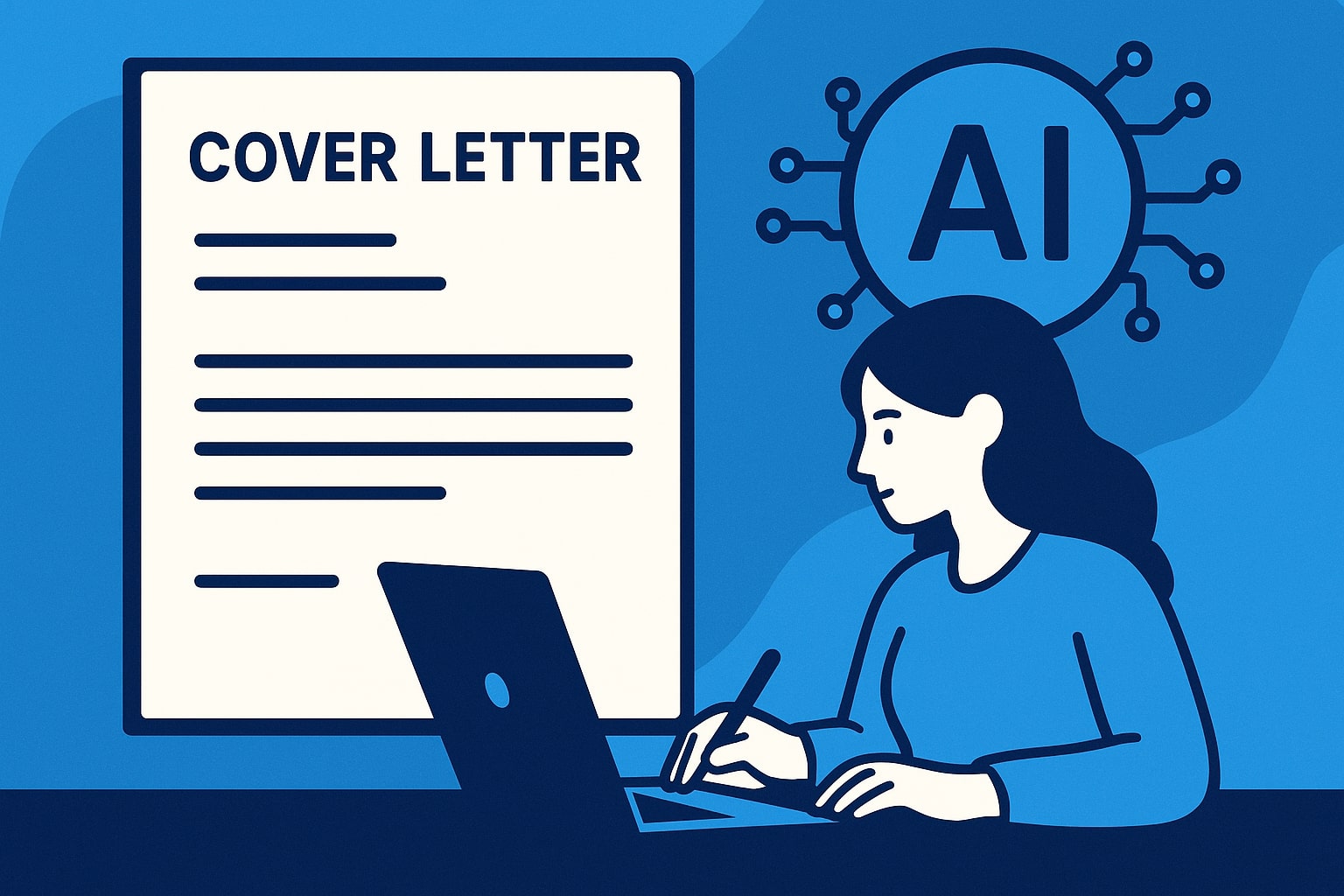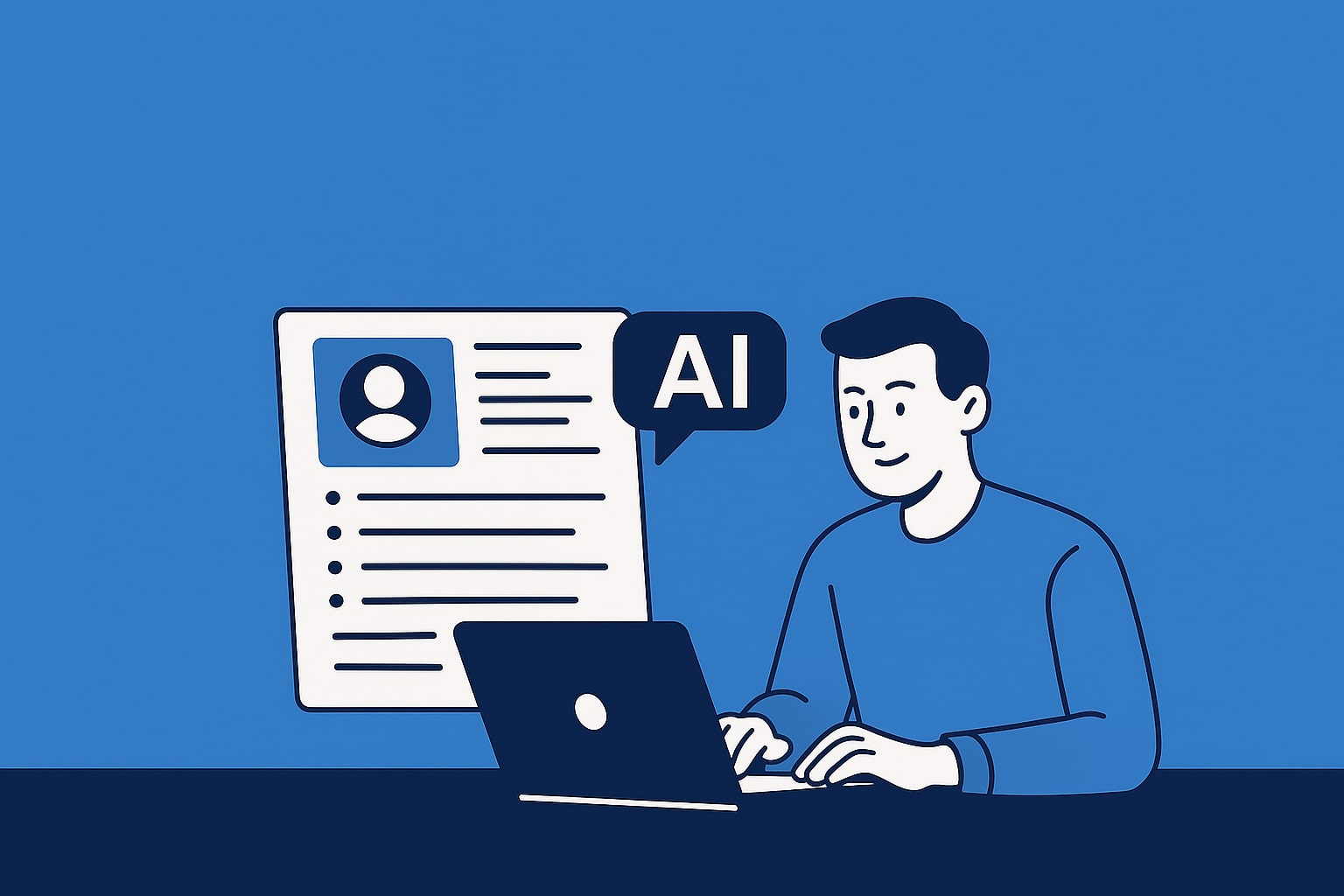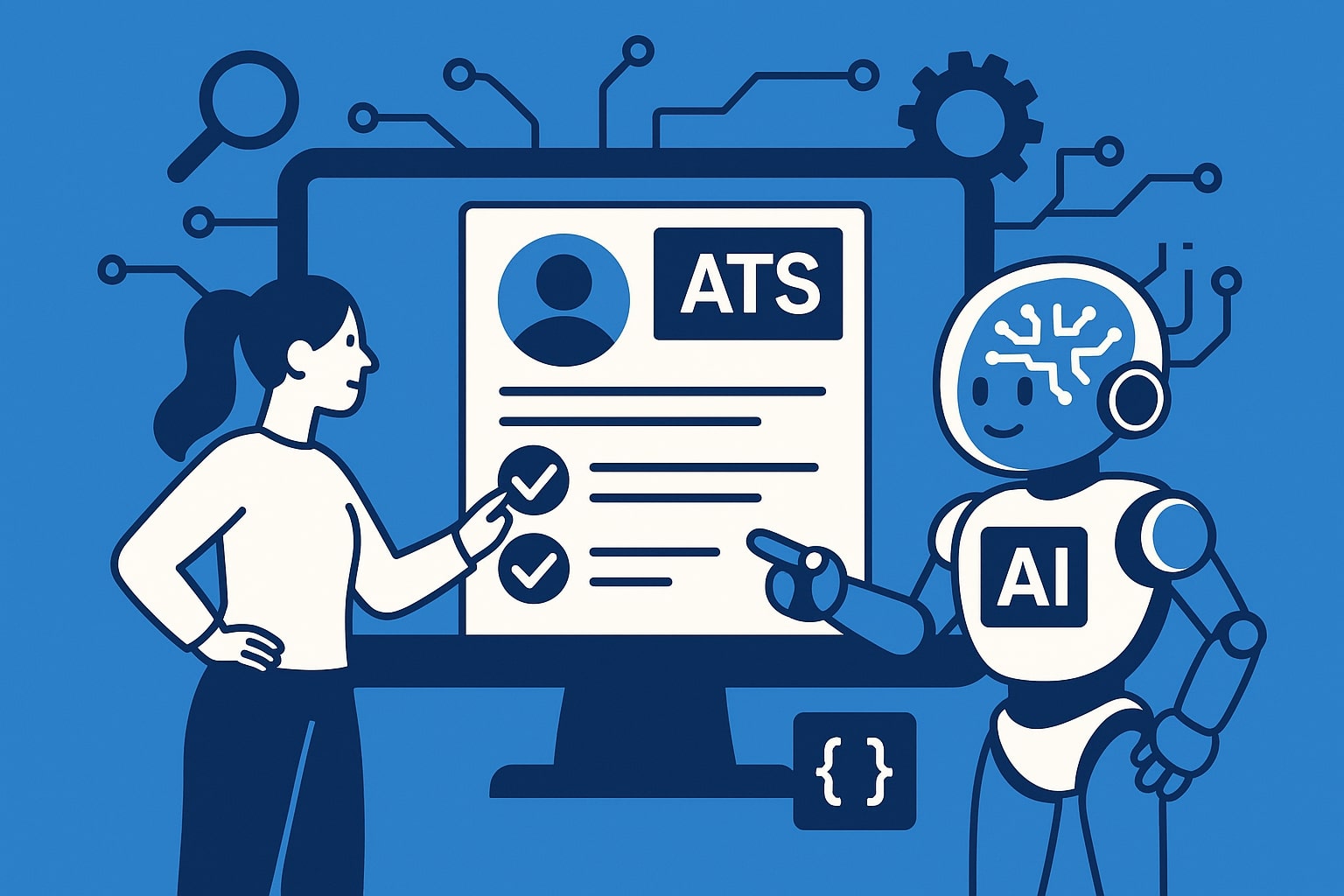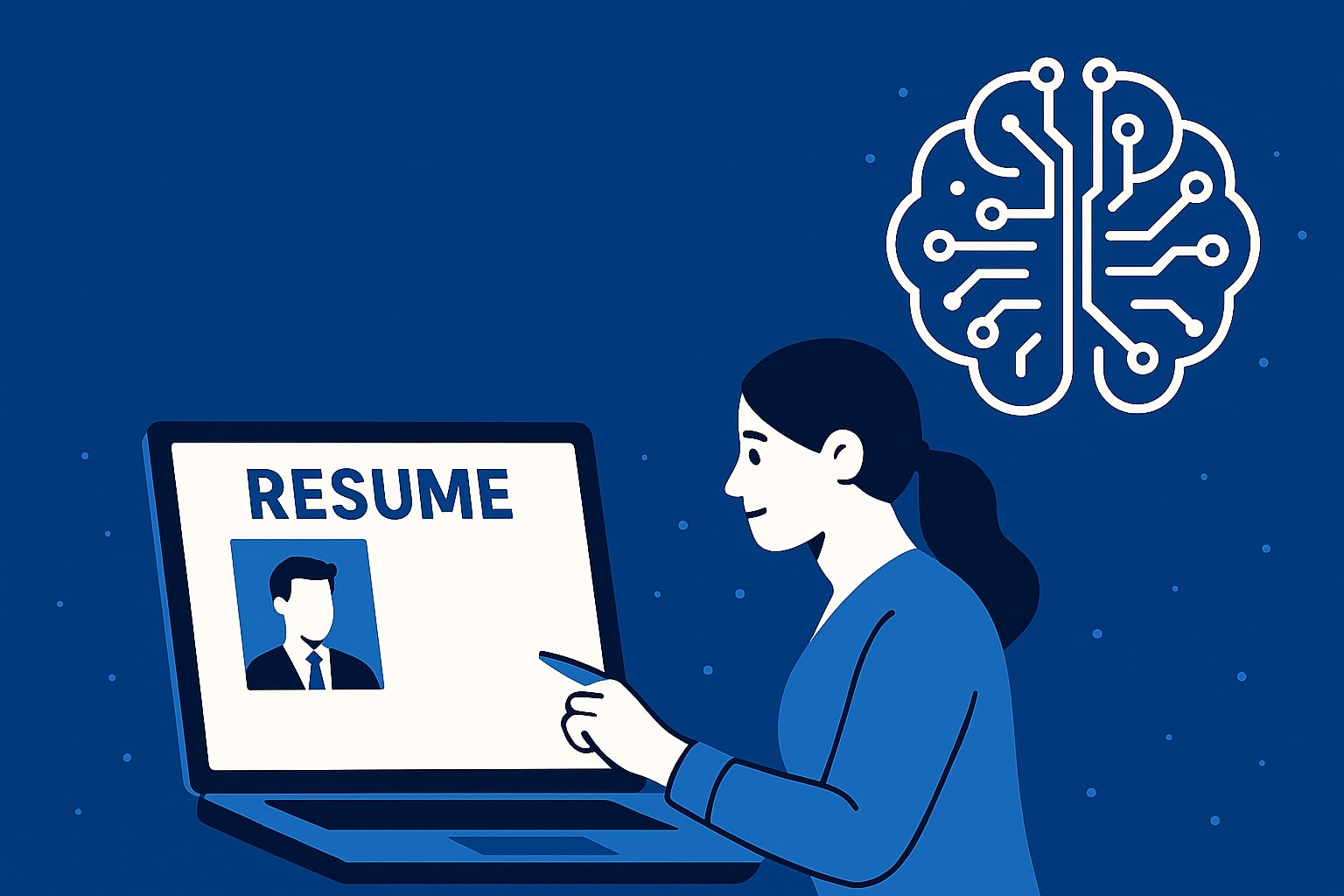Creating a compelling resume has never been more critical – or more challenging. With 87% of recruiters using Applicant Tracking Systems to filter candidates and hiring managers spending an average of just 7 seconds reviewing each resume, your application needs to be both machine-readable and human-engaging.
AI-powered resume writing tools have revolutionized this process, helping job seekers craft professional, optimized resumes in minutes rather than hours. This comprehensive guide shows you exactly how to leverage artificial intelligence to create a resume that passes ATS filters, captures attention, and lands interviews.
1. Understanding AI Resume Writing Technology
AI resume builders use natural language processing (NLP) and machine learning algorithms to analyze job descriptions, identify key requirements, and generate tailored content. These tools process millions of successful resumes to understand what works in different industries and roles.
Modern AI writing assistants go beyond simple templates. They analyze your input data – including work history, skills, and achievements – then generate compelling descriptions that highlight your value proposition. The technology considers factors like keyword density, readability scores, and industry-specific terminology to optimize every section.
The most sophisticated AI resume tools incorporate real-time labor market data to suggest in-demand skills and qualifications. They understand context, ensuring that a marketing manager’s resume emphasizes different competencies than a software developer’s, even when both professionals use similar project management tools.
- Natural Language Generation. AI transforms your basic job duties into achievement-focused bullet points that quantify impact and demonstrate value.
- Keyword Optimization. Algorithms identify and incorporate relevant keywords from job postings to improve ATS compatibility without keyword stuffing.
- Format Intelligence. AI selects optimal layouts based on your industry, experience level, and target role requirements.
- Content Personalization. Machine learning tailors language and emphasis to match company culture and job specifications.
These AI capabilities translate into tangible benefits for job seekers. Instead of struggling with writer’s block or wondering whether your resume meets industry standards, you can focus on providing accurate information while AI handles the optimization and presentation.
2. Essential Components of an AI-Optimized Resume
Every effective resume built with AI includes specific sections strategically crafted to maximize impact. Understanding these components helps you provide the right information for AI tools to work their magic.
Professional Summary Section
Your professional summary serves as the elevator pitch of your resume. AI tools analyze your experience and target role to craft a compelling 3-4 line summary that immediately communicates your value. This section should include your professional identity, years of experience, core competencies, and unique value proposition.
For example, instead of writing “Experienced marketing professional seeking new opportunities,” AI might generate: “Results-driven Digital Marketing Manager with 7+ years optimizing multi-channel campaigns for B2B SaaS companies. Proven track record of increasing qualified leads by 156% while reducing cost-per-acquisition by 43% through data-driven strategies and marketing automation.”
At JobWinner we offer an AI-powered professional summary generator that you can use to write a compelling resume.
Skills and Keywords Integration
AI excels at identifying and incorporating high-impact keywords that align with job requirements. The technology analyzes job postings to extract both hard skills (technical competencies) and soft skills (interpersonal abilities) that employers prioritize. With the ATS market expected to reach $6.31 billion by 2033, understanding keyword optimization becomes increasingly crucial for job seekers.
Modern AI resume builders maintain databases of industry-specific skills and their variations. They understand that “Python programming” might also appear as “Python development” or “Python scripting” in different job postings, ensuring your resume captures all relevant search terms.
| Section | Traditional Approach | AI-Optimized Approach |
|---|---|---|
| Skills Format | Random list of abilities | Categorized by relevance and priority |
| Keyword Density | Inconsistent or missing | Optimized for ATS without stuffing |
| Skill Descriptions | Generic terms | Industry-specific terminology |
| Competency Levels | Not indicated | Proficiency levels when relevant |
| Technical Skills | Mixed with soft skills | Separated and prioritized |
Work Experience Optimization
The work experience section benefits tremendously from AI enhancement. Rather than listing job duties, AI transforms your responsibilities into achievement-focused statements that demonstrate measurable impact.
AI analyzes successful resumes in your field to understand which accomplishments resonate with employers. It then helps you frame your experiences using powerful action verbs, quantifiable metrics, and industry-relevant context that positions you as a top candidate.
Consider how AI might enhance a basic responsibility: “Managed social media accounts” becomes “Orchestrated integrated social media strategy across 5 platforms, growing engaged community by 340% and generating $2.3M in attributed revenue through targeted content campaigns and influencer partnerships.”
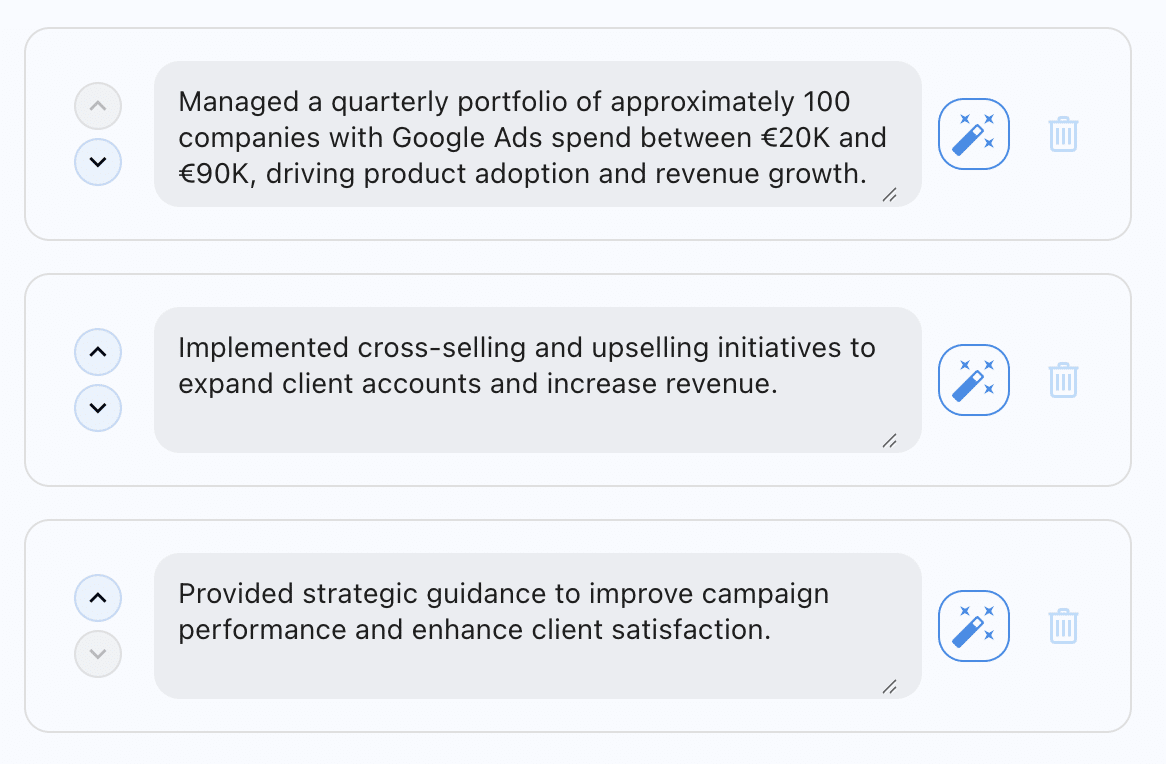
Want to rewrite your own resume bullet points like this? Try JobWinner’s free AI Resume Bullet Point Generator to instantly transform your responsibilities into high-impact achievements.
3. Step-by-Step Process for Creating Your AI Resume
Building an effective resume with AI requires a systematic approach. Following these steps ensures you maximize the technology’s capabilities while maintaining authenticity and accuracy.
Step 1: Gather Your Information
Before engaging with any AI tool, compile comprehensive information about your professional background. Create a master document containing all work experiences, educational credentials, certifications, achievements, and skills – even those that might seem tangentially relevant.
Include specific metrics and outcomes whenever possible: revenue generated, costs saved, processes improved, team sizes managed, project scopes, and timeline achievements. AI performs best when given concrete data to work with rather than vague descriptions.
Document the context surrounding your achievements. Note the challenges you faced, strategies you implemented, and results you achieved. This narrative information helps AI craft compelling stories that resonate with hiring managers.
Step 2: Analyze Target Job Descriptions
Collect 5-10 job postings for your target role from different companies. AI tools use these descriptions to identify patterns in requirements, preferred qualifications, and company priorities. The more examples you provide, the better AI can tailor your resume.
Pay attention to recurring themes across postings: common technologies, methodologies, soft skills, and industry terminology. These patterns indicate what employers consistently value, helping AI prioritize which aspects of your experience to emphasize. Consider enhancing your professional presence by following LinkedIn’s profile optimization best practices to align your online presence with your resume.
- ✓ Copy full job descriptions including requirements and responsibilities
- ✓ Note company-specific values and culture indicators
- ✓ Identify must-have versus nice-to-have qualifications
- ✓ Track salary ranges and seniority levels
- ✓ Document application deadlines and special instructions
- ✓ Save links for future reference and updates
Step 3: Select the Right AI Resume Tool
Choose an AI resume builder that aligns with your needs and industry. Consider factors like ATS compatibility guarantees, customization options, and industry-specific templates. Some tools excel at technical resumes while others specialize in creative or executive positions.
Evaluate whether you need basic AI assistance for formatting and keywords, or comprehensive AI writing that generates entire sections. Premium tools often include features like real-time content scoring, unlimited revisions, and direct integration with job boards.
Test the tool’s AI capabilities with sample information before committing. Quality AI resume builders should produce varied, natural-sounding content that doesn’t feel templated or generic. They should also allow you to edit and refine AI-generated suggestions.
Step 4: Input and Optimize Your Data
Enter your information systematically, starting with basic contact details and progressing through each section. Most AI tools use progressive prompting, asking targeted questions to extract relevant details about your experience.
Be specific when describing your roles and achievements. Instead of “improved sales,” specify “increased regional sales by 47% over 18 months by implementing consultative selling methodology and developing strategic partnerships with 3 major distributors.”
Review AI-generated content critically. While AI excels at optimization and formatting, you must ensure all information remains accurate and authentic to your experience. Adjust tone and emphasis to match your personal brand while maintaining AI-recommended keywords and structure.
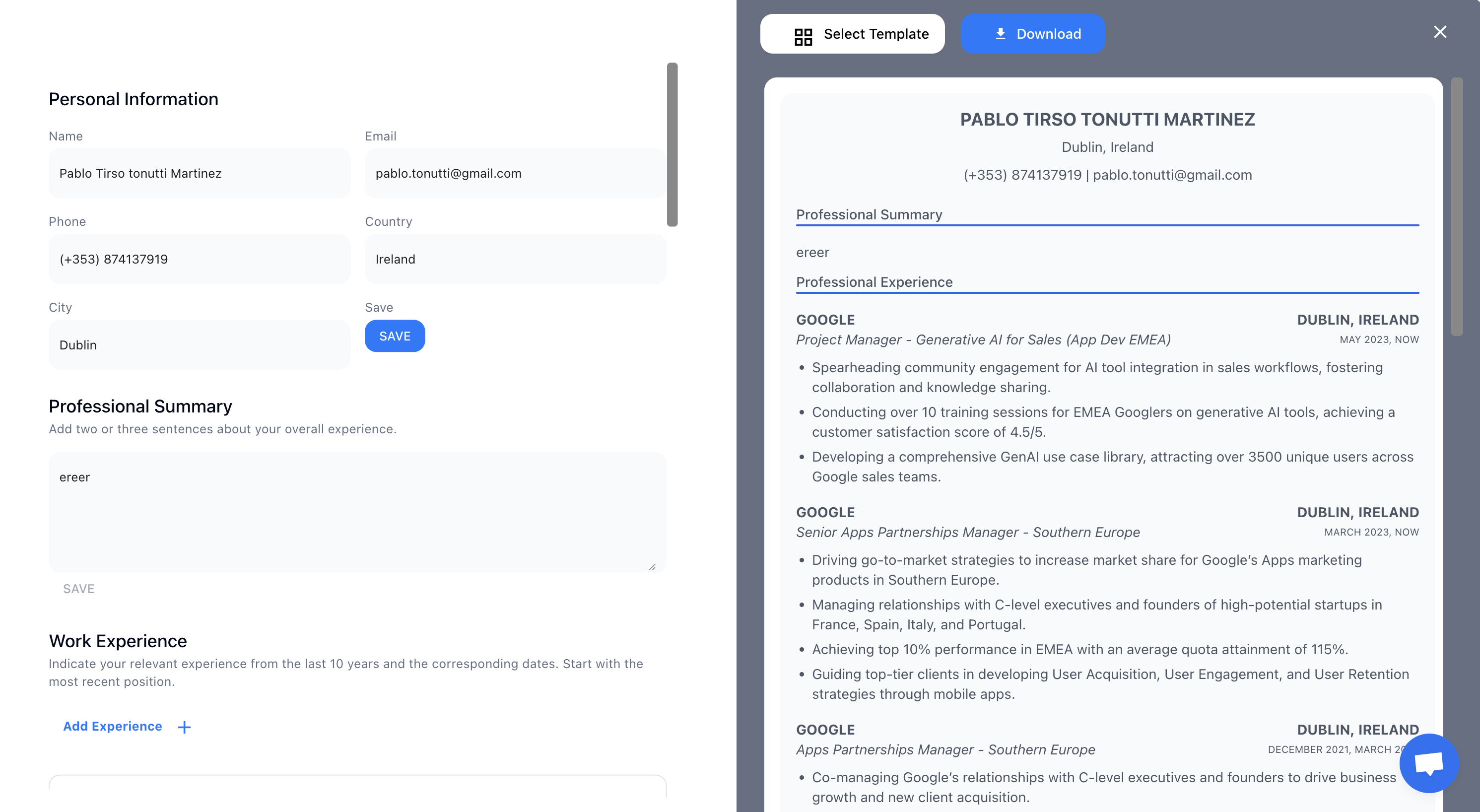 Screenshot of JobWinner AI Resume Builder
Screenshot of JobWinner AI Resume Builder
Step 5: Customize for Each Application
Use AI to create tailored versions for different opportunities. Modern AI tools can quickly adjust emphasis, reorder sections, and modify keywords based on specific job requirements without starting from scratch.
Upload each new job description to let AI identify unique requirements and preferences. The technology can detect subtle differences in priorities, helping you highlight the most relevant experiences and skills for each position.

4. Advanced AI Features That Make a Difference
Beyond basic resume generation, advanced AI capabilities can significantly enhance your job search success. Understanding these features helps you leverage the full potential of AI-powered resume tools.
Dynamic Content Scoring
Leading AI resume platforms provide real-time scoring algorithms that evaluate your resume against industry benchmarks and specific job requirements. These systems analyze factors including keyword relevance, readability, format effectiveness, and competitive positioning.
The scoring mechanism examines each section individually and holistically, identifying weaknesses that might prevent your resume from passing initial screening. It suggests specific improvements, from adding quantifiable achievements to adjusting sentence structure for better flow.
Some platforms use predictive analytics to estimate your resume’s success rate for specific positions. By comparing your profile against successful candidates who secured similar roles, AI can identify gaps and recommend strategic enhancements.
Intelligent Phrase Generation
AI’s natural language generation capabilities transform mundane job descriptions into compelling narratives. The technology understands context and nuance, selecting powerful action verbs and industry-appropriate terminology that resonates with hiring managers.
Rather than using generic phrases, AI crafts unique descriptions based on your specific situation. It considers factors like company size, industry sector, and role seniority to generate language that accurately reflects your experience level and achievements.

“Spearheaded cross-functional initiative to modernize legacy inventory system, reducing processing time by 67% and eliminating $450K in annual overtime costs while improving order accuracy from 94% to 99.7%”
ATS Compatibility Optimization
AI resume tools incorporate sophisticated ATS parsing technology to ensure your resume successfully navigates automated screening systems. They understand how different ATS platforms read and interpret resume data, optimizing format and structure accordingly.
The technology avoids elements that confuse ATS systems: complex tables, headers and footers, images, and unconventional fonts. Instead, it uses clean, parseable formats that maintain visual appeal while ensuring every piece of information is correctly extracted and categorized.
AI also manages keyword placement strategically, distributing relevant terms naturally throughout your resume rather than clustering them in one section. This approach satisfies ATS requirements while maintaining readability for human reviewers.
5. Common Mistakes to Avoid When Using AI for Resume Writing
While AI significantly improves resume quality, certain pitfalls can undermine its effectiveness. Understanding these common mistakes helps you maintain authenticity while leveraging AI’s capabilities.
Video on Pitfalls Using ChatGPT To Write Your Resume
Over-Reliance on Generic Templates
Many users accept AI-generated content without customization, resulting in generic-sounding resumes that fail to differentiate them from other candidates. While AI provides excellent starting points, your unique voice and specific experiences must shine through.
Avoid using AI-suggested phrases verbatim if they don’t accurately reflect your experience. The technology excels at structure and optimization, but you must ensure content authenticity. Modify AI recommendations to match your communication style and professional brand.
Remember that recruiters review numerous resumes daily and can recognize templated content. Use AI as a collaborative tool rather than a complete replacement for personal input, maintaining the human element that makes your application memorable.
Keyword Stuffing
Some job seekers mistakenly believe that maximizing keyword density improves their chances. However, excessive keyword repetition makes resumes difficult to read and can trigger ATS spam filters designed to identify manipulation attempts.
Modern ATS systems use semantic analysis to understand context and relevance. They recognize synonyms and related terms, making aggressive keyword stuffing unnecessary and potentially harmful. AI tools should balance keyword optimization with natural language flow.
| Mistake | Consequence | AI-Powered Solution |
|---|---|---|
| Keyword stuffing | Flagged as spam by ATS | Natural keyword integration with synonyms |
| Fictional achievements | Failed reference checks | Enhancement of real accomplishments |
| Inconsistent formatting | Parsing errors | Standardized, ATS-friendly layouts |
| Overlong descriptions | Lost reader attention | Concise, impactful bullet points |
| Missing contact info | Unable to contact | Complete header verification |
| Grammar errors | Perceived carelessness | Automated proofreading and correction |
Ignoring Industry Context
Generic AI tools might not understand specific industry nuances. A resume for a creative director requires different emphasis than one for a financial analyst, even when both roles involve project management and stakeholder communication.
Select AI tools that offer industry-specific optimization or manually adjust AI suggestions to align with sector expectations. Research industry standards and ensure AI-generated content reflects appropriate terminology, metrics, and priorities for your field.
Fabricating Information
Never use AI to create fictional experiences or exaggerate achievements beyond recognition. While AI can help articulate your accomplishments more effectively, all content must remain truthful and verifiable. Background checks and reference calls quickly expose fabrications.
Instead, use AI to identify and highlight genuine achievements you might have overlooked. The technology can help you recognize the value in routine tasks and frame them as meaningful contributions without resorting to dishonesty.

6. Industry-Specific AI Resume Strategies
Different industries have unique expectations for resume content and presentation. AI tools can adapt to these requirements when properly configured, helping you create targeted resumes that resonate with industry-specific hiring managers.
Technology and Software Development
Tech resumes require careful balance between technical proficiency demonstration and practical application examples. AI helps organize complex technical skills hierarchically, prioritizing languages, frameworks, and tools based on job requirements and industry trends.
For developers, AI can generate descriptions that emphasize code quality, system architecture contributions, and performance improvements. It understands the importance of quantifying technical achievements: reduced load times, improved test coverage, or decreased bug rates.
AI also helps navigate the challenge of listing technologies without overwhelming readers. It creates clean categorizations (frontend, backend, databases, tools) and emphasizes proficiency levels appropriately, ensuring recruiters quickly identify relevant expertise.
Healthcare and Medical Fields
Healthcare resumes must balance clinical expertise with administrative capabilities and patient care focus. AI trained on medical resumes understands the importance of licensures, certifications, and continuing education in healthcare careers.
The technology helps articulate patient outcomes, quality improvements, and compliance achievements using industry-standard metrics. It knows to emphasize both hard clinical skills and soft skills like empathy, communication, and cultural sensitivity that are crucial in patient care.
AI can also navigate the complexity of healthcare roles that span clinical and administrative responsibilities, ensuring both aspects receive appropriate attention based on the target position’s requirements.
Finance and Banking
Financial sector resumes demand precision in quantifying achievements and demonstrating regulatory knowledge. AI helps structure complex financial accomplishments, using industry-standard metrics like ROI, portfolio performance, and risk mitigation.
The technology understands financial terminology and can articulate experience with specific regulations, compliance frameworks, and financial instruments. It helps balance technical financial skills with relationship management and business development achievements.
- Quantified Results. AI converts vague financial achievements into specific metrics: assets under management, cost savings percentages, revenue growth figures.
- Regulatory Compliance. Intelligently incorporates relevant regulations (SOX, Dodd-Frank, Basel III) based on role requirements and geographic location.
- Technical Systems. Highlights experience with industry-standard platforms like Bloomberg Terminal, SAP, or specialized trading systems.
- Risk Management. Emphasizes risk assessment, mitigation strategies, and portfolio optimization using appropriate financial terminology.
Marketing and Creative Roles
Marketing resumes benefit from AI’s ability to balance creativity with data-driven results. The technology helps articulate campaign performance, audience growth, and brand impact using meaningful marketing metrics.
AI understands the importance of demonstrating both strategic thinking and execution capabilities. It crafts descriptions that showcase campaign ideation, cross-channel coordination, and measurable business impact without losing the creative spark that distinguishes marketing professionals.
For creative roles, AI helps strike the right tone – professional yet engaging, results-focused yet innovative. It knows when to emphasize awards and recognition versus ROI and conversion rates based on the specific marketing role and company culture.
7. Measuring and Improving AI Resume Performance
Creating your resume with AI is just the beginning. Continuous optimization based on performance metrics ensures your resume remains effective as you progress through your job search.
Tracking Application Success Rates
Monitor your application-to-interview conversion rate to assess resume effectiveness. A strong AI-optimized resume should generate interview invitations for 10-15% of applications when targeting appropriate positions.
Document which versions of your resume perform best with different types of employers. Track whether certain keywords, formatting choices, or content emphasis correlates with better response rates. Use this data to refine your AI inputs and optimization strategies.
Pay attention to the quality of opportunities that respond positively. If you’re getting interviews for positions below your target level, your resume might need adjustment to better communicate your seniority and expertise.
A/B Testing Resume Variations
Use AI to create multiple resume versions with subtle variations in structure, keywords, or emphasis. Test these versions systematically across similar job applications to identify which elements resonate most effectively.
Consider testing different professional summary approaches: achievement-focused versus skill-focused, or industry-specific versus role-specific. AI can quickly generate these variations while maintaining consistency in core information.
- Week 1-2 Establish baseline with current resume version
- Week 3-4 Test modified professional summary
- Week 5-6 Experiment with reordered sections
- Week 7-8 Try different keyword densities
- Week 9-10 Adjust achievement quantification
- Week 11-12 Implement winning combination
Gathering and Implementing Feedback
When you receive specific feedback from recruiters or hiring managers, use it to refine your AI resume strategy. If multiple reviewers mention missing skills or unclear progression, adjust your AI inputs to address these gaps.
Participate in resume review sessions or seek feedback from industry professionals. Their insights can help you identify whether AI-generated content accurately represents industry expectations and standards.
Remember that AI tools continuously improve through machine learning. Many platforms allow you to provide feedback on generated content, helping improve suggestions for yourself and other users. Actively participating in this feedback loop enhances the tool’s effectiveness.
Staying Current with AI Updates
AI resume technology evolves rapidly, with platforms regularly updating their algorithms based on changing hiring trends and ATS requirements. Stay informed about new features and capabilities that could enhance your resume’s effectiveness.
Subscribe to updates from your chosen AI resume platform and participate in user communities where best practices are shared. Understanding new features as they’re released helps you maintain a competitive edge in your job search.
8. The Future of AI in Resume Writing and Career Development
AI resume technology continues advancing rapidly, with emerging capabilities that will further transform how job seekers present themselves to potential employers. Understanding these trends helps you prepare for the future of AI-assisted job searching.
Predictive Career Pathing
Next-generation AI tools are beginning to offer predictive career guidance based on your experience, skills, and market trends. These systems analyze thousands of career trajectories to suggest optimal next steps and identify skill gaps to address.
By understanding career progression patterns in your industry, AI can recommend strategic resume adjustments that position you for future opportunities, not just current openings. This forward-looking approach helps you build a resume that supports long-term career goals.
Some platforms are experimenting with AI that suggests lateral career moves or emerging roles where your skills might transfer effectively. This capability becomes increasingly valuable as traditional career paths become less linear and industries continue evolving.
Real-Time Market Integration
Future AI resume tools will incorporate live job market data to provide dynamic optimization suggestions. As skill demands shift and new technologies emerge, your resume can automatically adapt to maintain relevance.
Imagine AI that alerts you when your skill set becomes more valuable in certain markets or when new certifications would significantly boost your marketability. This proactive guidance helps you stay ahead of market changes rather than reacting to them.
Integration with professional networking platforms and job boards will enable AI to provide increasingly personalized recommendations based on actual hiring patterns and success rates for professionals with similar backgrounds.
Video and Multimedia Resumes
As video resumes and digital portfolios become more common, AI is developing capabilities to optimize multimedia content. This includes automated video editing, speech coaching, and visual presentation enhancement.
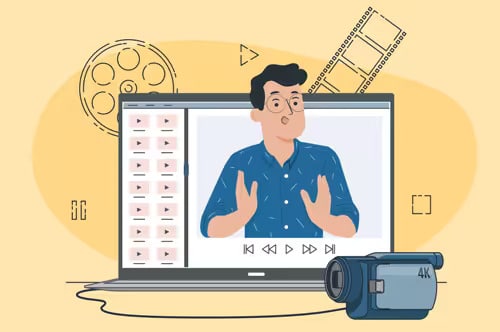
Illustration of a man giving a presentation on a laptop screen.
AI can analyze successful video resumes to recommend optimal length, pacing, and content structure. It might suggest which achievements to highlight visually versus verbally, helping you create compelling multimedia presentations that complement traditional resumes.

“Interactive resumes that adapt content based on viewer behavior, personalized video introductions generated from text inputs, and augmented reality portfolios that showcase work samples in immersive formats”
Ethical Considerations and Best Practices
As AI becomes more sophisticated, maintaining ethical standards in resume creation becomes increasingly important. The technology should enhance authentic representation rather than enable misrepresentation or discrimination.
Industry leaders are developing ethical guidelines for AI resume tools, ensuring they promote diversity and inclusion while preventing bias in keyword selection or content generation. Users must understand their responsibility to verify all AI-generated content for accuracy.
The future of AI resume writing will likely include transparency features that help hiring managers understand which content is AI-assisted versus human-written, promoting trust while acknowledging the value of AI optimization.
9.Conclusion
AI has fundamentally transformed resume writing from a daunting task into a strategic, data-driven process. By leveraging AI’s capabilities for optimization, personalization, and continuous improvement, job seekers can create resumes that effectively communicate their value while navigating the complexities of modern hiring systems.
Success with AI resume writing requires understanding both the technology’s capabilities and its limitations. Use AI as a powerful tool to enhance your authentic professional story, not replace it. Combine AI’s optimization power with your unique experiences and genuine achievements to create resumes that stand out in competitive job markets.
As you implement these strategies, remember that your resume is a living document that should evolve with your career and the changing job market. Regular updates using AI insights ensure your professional presentation remains current, compelling, and competitive. Start leveraging AI for your resume today, and position yourself for success in tomorrow’s job market.
10. Frequently Asked Questions
How accurate are AI-generated resume descriptions?
AI-generated descriptions are typically 85-90% accurate in capturing role requirements and using appropriate industry terminology. However, you must review and customize all content to ensure it accurately reflects your specific experiences and achievements. AI excels at structure and optimization but requires human oversight to maintain authenticity and accuracy. Always verify that quantified achievements and technical skills listed match your actual experience.
Will employers know if I used AI to write my resume?
Employers generally cannot definitively identify AI-assisted resumes when properly customized. The key is personalizing AI-generated content to reflect your unique voice and experiences. Many hiring managers expect candidates to use modern tools for resume optimization, similar to using spell-check or grammar assistance. Focus on ensuring authenticity rather than hiding AI use – the goal is creating an effective resume that accurately represents your qualifications.
Can AI help with resume gaps or career changes?
AI tools excel at addressing resume gaps and career transitions by identifying transferable skills and reframing experiences. They can suggest alternative formats like functional or combination resumes that emphasize skills over chronology. AI helps articulate how seemingly unrelated experiences contribute to your target role qualifications. For gaps, AI can help you frame productive activities during time away from traditional employment, such as freelance work, education, or skill development.
How often should I update my AI-optimized resume?
Update your AI-optimized resume every 3-4 months even when not actively job searching, and customize it for each application when job hunting. Regular updates ensure you capture recent achievements while they’re fresh and incorporate evolving industry keywords. AI tools can quickly refresh content based on new experiences or changing market demands. Set quarterly reminders to review and update your resume, adding new projects, skills, or accomplishments.
What’s the cost range for quality AI resume tools?
AI resume tools range from free basic versions to premium subscriptions costing $15-50 monthly. Free tools typically offer limited templates and basic keyword optimization. Mid-tier options ($15-25/month) include advanced AI writing, unlimited revisions, and ATS scoring. Premium services ($30-50/month) add features like career coaching, cover letter generation, and LinkedIn optimization. Consider starting with free trials to evaluate which features provide the most value for your needs.
Should I use the same AI tool for cover letters?
Using the same AI platform for resumes and cover letters ensures consistency in tone, style, and messaging. Most quality AI resume tools include cover letter features that reference your resume content, creating cohesive application packages. AI can help match cover letter keywords to specific job postings while maintaining narrative flow. However, cover letters require more personalization than resumes – use AI for structure and optimization, but inject personal enthusiasm and company-specific details.
How do AI resume tools handle technical or specialized roles?
Advanced AI resume platforms maintain specialized databases for technical and niche roles, understanding industry-specific terminology, certifications, and skill hierarchies. They can differentiate between junior and senior-level technical competencies, properly categorize programming languages or specialized equipment, and emphasize relevant project methodologies. For highly specialized roles, choose AI tools with industry-specific training and verify technical accuracy carefully.
Can AI help with federal or government resume formats?
Yes, specialized AI tools understand federal resume requirements including detailed work histories, hours per week, supervisor information, and KSA (Knowledge, Skills, and Abilities) statements. They can expand private sector resumes into the comprehensive federal format, ensuring all required elements are included. AI helps translate accomplishments into the specific language federal agencies expect while maintaining proper USA Jobs formatting. Remember that federal resumes typically run 4-6 pages, much longer than private sector versions.
How does AI handle international resume differences?
Quality AI platforms recognize regional resume preferences – CV format for Europe, resume style for North America, and specific requirements for markets like Japan or Australia. They adjust content length, photo inclusion, personal information disclosure, and terminology based on target country standards. AI can convert between formats, ensuring appropriate date formats, spelling variations (optimize vs optimise), and cultural expectations. Always verify local requirements as practices vary significantly between countries and industries.

